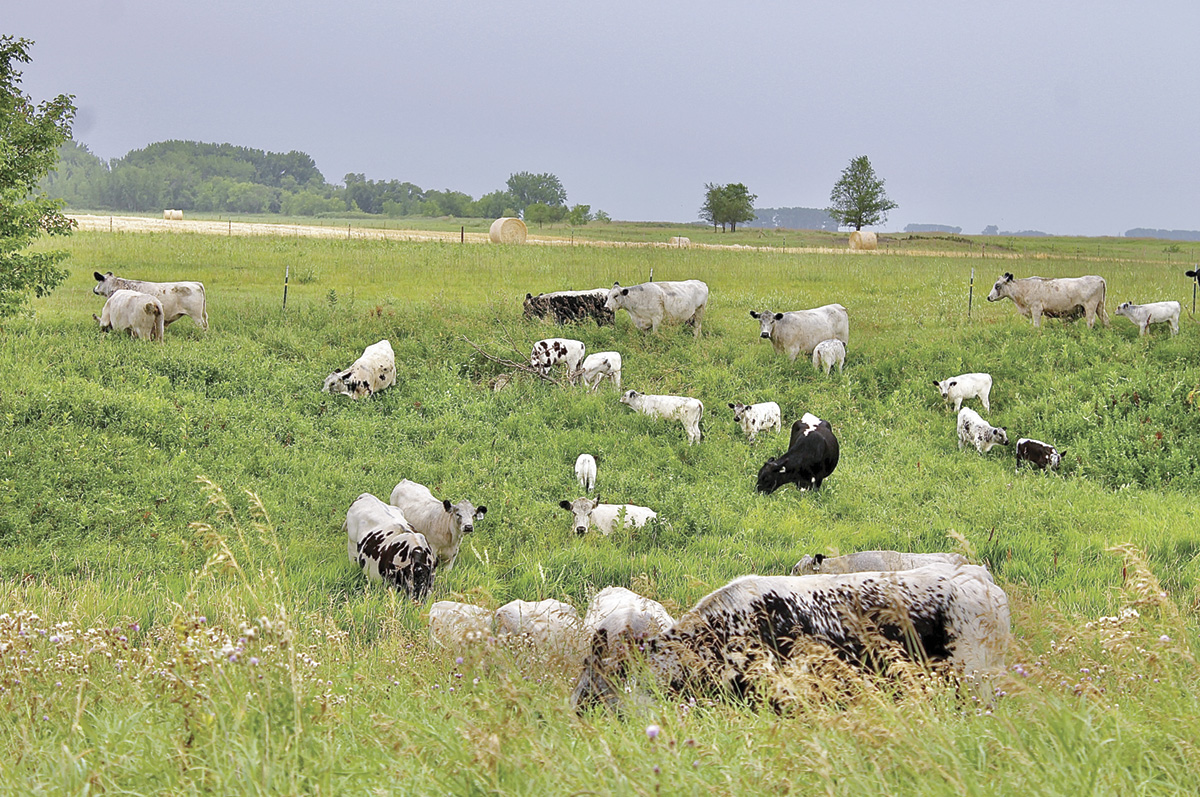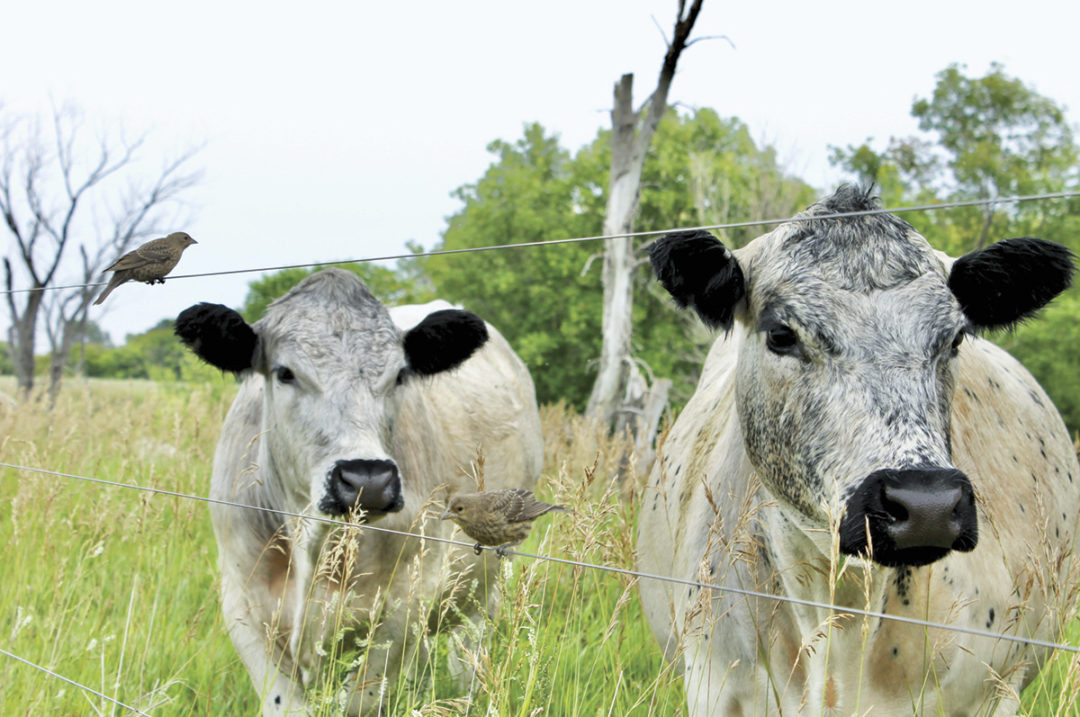Grass-fed beef is a growing niche market in the U.S. Consumers are also showing an increased interest in learning where their food comes from. Combining this niche market with direct marketing creates a great opportunity for beef producers.
Grass-fed beef management
With information and research readily available from sources such as the American Grassfed Association (AGA) and other breed registries, producers interested in learning more about grass-fed beef management practices and procedures have plenty of resources to help them successfully raise their beef.
“Options and variety are the best things producers can offer their customers,” says Amy Germolus, owner of South Branch British Whites in Borup, Minnesota. With these options, misconceptions can arise about both. One misconception that has surrounded raising grass-fed beef is that they can’t get fat.
Christina Traeger, fifth-generation farmer and AGA-certified grass-fed beef producer of Rolling Hills Cattle Company in Avon, Minnesota, has a cow-calf to finish grass-fed beef operation. She also raises and sells pork, lamb and poultry. Traeger explains, “If you have the Brix in your grass up around 11 percent, they are going to finish just as if you put them on grain. A lot of this is management.” Brix (°Bx), is the unit measurement used to evaluate sugar and water-soluble content in forages.
Germolus explains that more intensive management is needed, depending on what kind of paddock or pasture situation you have. “Rotational grazing is used on our farm because we have a limited amount of pasture, and it maximizes productivity. It creates better soil health and, in turn, better cares for the land.”
Rolling Hills Cattle Company has rotationally grazed for more than 20 years and practices no-till. Traeger explained that in the summer, her cattle graze on leased government land and, throughout the fall, continue grazing as weather allows with the supplementation of hay from land managed the same as her pastures during the prime time of growth. The animals will go back on that land, funneling nutrients from the manure back into the soil. Traeger also explains that with this management protocol, after the cows go through and graze, her turkeys are out there scratching the cow pies apart, spreading it further; the dung beetles are out there at work as well. From Traeger’s observations, all species work together and benefit from one another in different ways.
Consumer demand
Traeger explains that when people are looking for grass-fed beef, they are not just looking for if it was raised on a pasture. “Consumers have a choice,” she says. “They can get it from Australia cheap, and they can get it from New Zealand cheap, but where are they sending their money? It comes down to what they want to support and why.”
Traeger sells her meat directly from the ranch and at local farmers' markets. She says most of her beef cuts sell relatively evenly. One week, the ribs will be a big seller, the next week people may want to do kabobs or stir fry, or may prefer a beef roast that will last the whole week – stretching their food budget. There is always a demand for certain cuts, so maximizing and stockpiling cuts and bundles are important – it all balances out in the end. Finding balance and knowing your consumers and what they like is essential to selling retail. “Each community is different,” Traeger says. “You can sell at eight different farmers' markets and there are going to be eight different towns, with people who are going to eat eight different ways.”

Germolus utilizes rotational grazing on her farm to get the most out of her limited pasture. Photo by Olivia Sip.
Labeling
When labeling beef or your product, Traeger explains that there needs to be integrity in it. Traeger stays away from label claims when marketing her beef because labels can be biased. Rather, she explains to the consumer about her product and how she raises it. “Labeling can be very greenwashed,” says Traeger. When grass-fed beef prices went up, a premium was applied, and some people would take advantage of that to say their cattle were grass-fed when they weren’t. “There has to be integrity,” she stresses.
Germolus also says clear explanations are important. “Labels can be confusing for consumers and producers alike, determining the meanings of grass-fed, grass-finished or grain-finished. Clarity and openness with your customers is key.”
Using British Whites
Both Germolus and Traeger consider raising British Whites a superior advantage when producing grass-fed beef. “British Whites are a very docile breed of cattle, they are beautiful to look at, and they hold their condition exceptionally well even if you are stretching feed in drought or low-yielding years by incorporating straw into their ration,” explains Germolus. She also says British Whites are known to have well-marbled beef with less backfat than conventionally finished beef.
They both also say they see less yellow fat in their finished beef. “Commonly seen in grass-fed beef is yellow-toned fat. We've noticed that the British White beef fat remains white,” says Germolus. Traeger explained that the color is influenced by intake of beta carotene, a natural form of vitamin A. If the cattle are getting a lot of vitamin A through the grass, it can, in some animals, cause yellowing to the fat, but not always. “Most of the fat in my animals is white,” says Traeger. “The only time I will see yellowing is typically in an old cow that’s really lean or in an animal that has a little bit of Jersey in it.” Fat color doesn’t affect the taste or tenderness of the meat.
British Whites thrive in all conditions; they are an easy choice for those choosing to do grass-fed. They are recognized for their mothering abilities, docility and competitive growth rates. British Whites are commonly seen as having a white body with black points on the ears, eyes, nose, feet, legs and teats. “The black pigment in their hide prevents sunburn, which in turn prevents cancer,” explains Traeger.
Taste
Flavor can be impacted by several things: breed of cattle, variety of grasses, weather conditions that affect forage growth and finishing on hay or fresh grasses. Austen Germolus, farm manager at South Branch British Whites and former butcher and meat scientist, explains that grass-fed beef is known for its darker color and its bold, rich flavor. The Germoluses offer federally inspected retail cuts as a way for people to try this flavor, since much of their customer base hasn’t experienced grass-fed beef before. Along with selling individual retail cuts, they sell bundle boxes and bulk shares. “You have to try grass-fed beef. It’s hard to explain the unique flavor, especially if people aren’t very familiar with flavor profiles, such as umami,” Austen explains. The taste known as "umami" is derived from the Japanese word for delicious. “We all know salty and sweet, sour and bitter,” he says. “Grass-fed beef has a more intense umami flavor.”
With this information, will you be giving grass-fed beef a try for your next meal?









